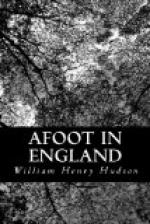Looking back at the great round hill from the village it is impossible not to notice the intense red colour of the road that winds over its green slope. One sometimes sees on a hillside a ploughed field of red earth which at a distance might easily be taken for a field of blossoming trifolium. Viewed nearer the crimson of the clover and red of the earth are very dissimilar; distance appears to intensify the red of the soil and to soften that of the flower until they are very nearly of the same hue. The road at Abbotsbury was near and looked to me more intensely red than any ordinary red earth, and the sight was strangely pleasing. These two complementary colours, red and green, delight us most when seen thus—a little red to a good deal of green, and the more luminous the red and vivid the green the better they please us. We see this in flowers—in the red geranium, for example—where there is no brown soil below, but green of turf or herbage. I sometimes think the red campions and ragged-robins are our most beautiful wild flowers when the sun shines level on the meadow and they are like crimson flowers among the tall translucent grasses. I remember the joy it was in boyhood in early spring when the flowers were beginning to bloom, when in our gallops over the level grass pampas we came upon a patch of scarlet verbenas. The first sight of the intense blooms scattered all about the turf would make us wild with delight, and throwing ourselves from our ponies we would go down among the flowers to feast on the sight.
Green is universal, but the red earth which looks so pleasing amid the green is distributed very partially, and it may be the redness of the soil and the cliffs in Devon have given that county a more vivid personality, so to speak, than most others. Think of Kent with its white cliffs, chalk downs, and dull-coloured clays in this connection!
The humble subterraneous mole proves himself on occasions a good colourist when he finds a soil of the proper hue to burrow in, and the hillocks he throws up from numberless irregular splashes of bright red colour on a green sward. The wild animals that strike us as most beautiful, when seen against a green background, are those which bear the reddest fur—fox, squirrel, and red deer. One day, in a meadow a few miles from Abbotsbury, I came upon a herd of about fifty milch cows scattered over a considerable space of ground, some lying down, others standing ruminating, and still others moving about and cropping the long flowery grasses. All were of that fine rich red colour frequently seen in Dorset and Devon cattle, which is brighter than the reds of other red animals in this country, wild and domestic, with the sole exception of a rare variety of the collie dog. The Irish setter and red chouchou come near it. So beautiful did these red cows look in the meadow that I stood still for half an hour feasting my eyes on the sight.




